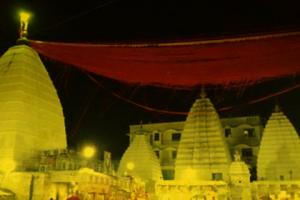Contents
4. Method of performing Tarpan
4. Pitrutirtha: When should it be done?
5. Tarpanof sesame seeds (tila tarpan)
6. Importance of performing tila tarpan
1. Terminology of Shraddha
A) Pitar
When a human being dies, its subtle body gets freed from the dead body after performing the ritual of Shraddha and it gets position in the subtle plane meant for souls of dead persons. At that moment it assumes the designation of Pitar.
B) Parvan
After performing Sapindikaran Shraddha (Shraddha performed one day prior to one-year completion after the death of the person is called Sapindikaran Shraddha), the soul that has assumed the designation of Pitar now joins other Pitars and then gets further categorised as Parvan. Also, it gains authority so as to allow its descendants to perform Parvan Shraddha for it.
C) Pitrutrayi (Trio in Pitars)
Generally son of the dead person has authority to perform Shraddha for the dead person. In his absence, other options are explored. The terminology of Shraddha has been prepared assuming the son as being the person who performs the shraddha. Therefore the soul of dead person for whom the Shraddha is being performed, is invoked as ‘pita’ (father of the son performing Shraddha). One generation before, i.e. the father of dead person is referenced as ‘Pitamaha’ (grandfather of the son performing Shraddha). The grandfather of the dead person is referred to as ‘Prapitamaha’ (great grandfather of the son performing Shraddha). The earlier generations than these are not counted in trios of Pitars (Pitrutrayi), because it is assumed that they are liberated.
D) Jivatpitruk
When there is a male person whose father is alive, then such a person does not have authority to perform Shraddha. But he has right to perform Shraddha for his mother and grandfather (mother’s father). Also, generally, he even does not have the right to perform rituals of Narayannagbali, Tripindi etc; however if these rituals are performed with the objective of conceiving a child, then the jivatpitruk can do so. In order to perform ‘Apasavya’, a jivatpitruk can only hold the thread in the thumb of the left hand and cannot hold it completely in his left hand.
E) Three ways of wearing the thread (janve) are Savya, Apasavya and Nivit
The thread should always be worn on the left shoulder. This style of wearing the thread is known as ‘savya’. When it is worn on the right shoulder it is known as ‘Apasavya’. When worn as a necklace, it is known as ‘Nivit’.
F) Offering ‘kshan’
During the ritual of shraddha, the deity and the deceased ancestors’ soul are invited by offering grass twigs (darbha) to them. This is called the offering ‘kshan’.
G) Pishangi
Rangoli drawn using ash and with chanting of mantras around the meal plate arranged for the priest (Brahmin) is called as pishangi. (Offering food to priest (Brahmin) is considered as an important part of Shraddha). Rangoli is drawn in a clockwise direction (similar to circumambulation) around the food offering plate arranged for the deity and in the reverse direction around the plate arranged for the ancestors’ soul. Pishangi is one of the aspects of the ritual of shraddha. Nowadays, Pishangi is drawn only in case of offering of Pinda (Pinda daan). However, Pishangi should be drawn during all types of shraddha.
H) Vikir
During Shraddha, after finishing offering of Pinda (Pinda daan) and worship of Pinda, ‘Savya’ is performed and a morsel of rice is kept in front of the plate with the food offering arranged for the Deity. This is termed as Vikir.
I) Prakir
After performing Vikir, ‘Apasavya’ is done and a morsel of rice is kept in front of the plate which has the meal arranged for deceased ancestors’ soul. This is called as Prakir.
J) Ucchista Pinda
After performing Prakir, pinda is kept for the ones who have died by getting burnt in a fire or due to partial burning, or for the dead foetus, near the plate of food arranged for the deceased ancestors’ soul or close to other offerings of pinda.
K) Shraddha Sampat
If two shraddhas occur on the same date (as per Hindu calendar) then it is termed as Shraddha Sampat.
2. Tarpan and Pitru tarpan
2.1 Tarpan
A) Significance and meaning
‘Trup’ means satisfying others. The word ‘Tarpan’ has been formed from the root word ‘Trup’. Offering water to God, Sages, ancestors’ soul and human beings and satisfying them through it is called tarpan.
B) Objective
The objective of performing tarpan is that God, deceased ancestors’ souls etc. whose names are pronounced while performing Tarpan, should bestow happiness on us.
C) Types
Brahmayadnyang (performed during sacrificial fires), snanang (performed daily after bath), shraddhang (performed during Shraddha) are the various types of Tarpans that are part of the various rituals and should be performed during the respective occasions.
D) Method of performing Tarpan
1. Bodhayan has mentioned that ‘Tarpan should be performed at the riverside’. While performing Tarpan at the riverside, one should stand in the river so that the water level touches the belly button or one should perform tarpan by sitting on the banks of the river.
2. Tarpan for God and Sages should be performed by facing East and that for deceased ancestors’ souls it should be performed by facing South.
3. As per science, tarpan for God should be performed after doing ‘Savya’, that for Sages should be performed after doing ‘Nivit’ and for deceased ancestors’ souls after doing ‘Apasavya’.
4. A dried grass twig (darbha) is necessary for performing tarpan. Tarpan for God is performed from the tip of the darbha, tarpan for Sages should be performed by folding the darbha in the middle, and tarpan for deceased ancestors’ souls should be performed from the tip and root of the two darbhas.
5. Offering of water (tarpan) to deities should be done using the finger tips, while offering of water to Sages should be done from the base of the little finger and the third finger and that to the deceased ancestors’ souls should be done through the mid of the thumb and the first finger of the hand.
6. Tarpan should be performed taking one handful (anjali) of water for each deity, two handful of water for Sages and three handful of water for deceased ancestors’ souls. In case of matrutrayi (mother, grandmother and great grandmother) three handful of water should be used and for other females ancestors’ souls one handful of water should be used for tarpan.(8)
(Original meaning of word ‘anjali’ is handful (‘onjal’). In this context, however, ‘giving one handful (anjali) of water for tarpan’ is to indicate that the tarpan should be given only once – Compiler)
2.2. Pitru tarpan
A) Meaning
Offering of water to deceased ancestors’ souls (pitar) is called as Pitru tarpan. A Jivatpitruk is not allowed to perform Pitrutarpan.
B) Why should it be done ?
Apart from expectation of Pinda and offering of food to priests (Brahmins) from its descendants, the deceased ancestors’ souls also expect offering of water (udak) from them.
C) Importance
By performing tarpan, the deceased ancestors’ souls not only get satisfied and leave us, but they also bestow long life, radiance, superior intellect (brahmavarchaswa), wealth, success and foodstuff (ability to digest the food consumed) on the host performing the tarpan and satisfies him too.
D)Pitrutirtha
When should it be done?
1. Tarpan for God, Sages and deceased ancestors’ souls should be performed regularly (daily). The daily ritual of tarpan should be accomplished in the early morning after having bath. If it is not possible to perform Shraddha for deceased ancestors’ souls daily, then one should at least perform tarpan.
2. Pitru tarpan should be performed on the day following the day on which Parvan Shraddha is performed.
E) Tarpan of sesame seeds (tila tarpan)
Sesame seeds should be used in the ritual of Pitru tarpan. Sesame seeds are available in two varieties, black and white. Black sesame seeds should be used for Shraddha.
1. Tila tarpan means offering sesame seeds mixed in water to the deceased ancestors’ souls.
2. Tila tarpan (as a part of Shraddha) should be offered to the same number of ancestors’ souls for whom the shraddha has been performed.
3. Tila tarpan is performed before Darsha shraddha and in case of annual shraddha; tila tarpan is performed on the following day of the shraddha. In case of any other shraddha, tila tarpan is performed just after performing the shraddha.
4. Tila tarpan is not performed during Nandi Shraddha, Sapindi Shraddha etc. (9)
F) Importance of performing tila tarpan
1. Sesame seeds are the favorites of deceased ancestors’ souls.
2. On the day of Shraddha, sesame seeds should be sprinkled all over the house, sesame seeds mixed in water should be given to the invited priests (Brahmins) and sesame seeds should be donated. – Jaiminiya Ghruya sutra (2.1), Boudhayan Dharmasutra (2.8.8) and Boudhayan Ghruya sutra
Reproduced with permission from https://www.sanatan.org/en/
The comments are owned by the author. We aren’t responsible for their content.











Add Comment